Moissanite vs Diamond – Which is Better? (Video Comparison)
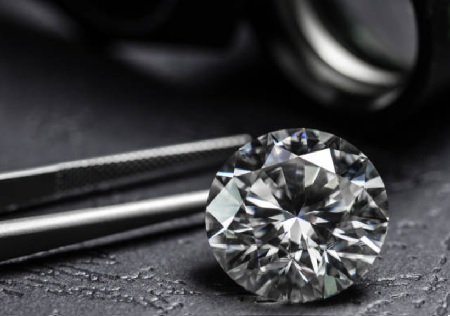
Out of the many simulants available in the market, moissanite is perhaps the most popular alternative to buying a diamond. In this write up, we will take a detailed look at the similarities and differences between moissanite and diamond.
We will also answer commonly asked questions like: “Is one better than the other?” and “How do they look like in real life?” with video comparisons and real-life photographs.
Hopefully, this gives you a better understanding of what diamonds and moissanite really are and which might best suit your needs.
Let’s dive in…
First of All, What is Moissanite?
In 1893, moissanite (silicon carbide) was first discovered in Arizona by Dr. Henry Moissan who later went on to win a Nobel prize in chemistry. It is extremely rare in nature and exist in colorless, green and yellow hues.
One of the reasons behind moissanite’s popularity in jewelry is due to its physical and chemical properties. Moissanite is transparent and extremely hard (scores 9.25 on the Mohs scale). As a result, they can be easily faceted and polished to good luster.
Moissannite is also doubly refractive and has a high index of refraction which gives them a distinctive look. In layman’s terms, when light passes through moissanite, it gets bent more and this results in more light dispersion (fire).
Today, nearly all the moissanite used in jewelry are artificially synthesized in laboratories. Most notably, one of the largest producers in the world is a company called Charles & Colvard and they were the first to patent a process of mass-producing moissanite.
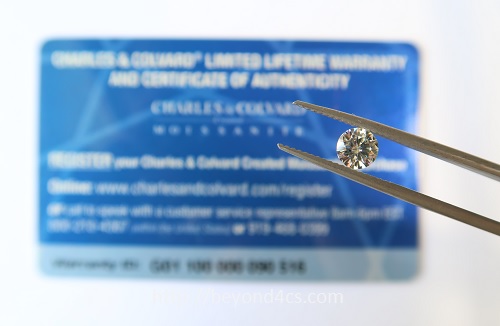
0.50ct moissanite I purchased from Charles & Colvard
Next, What is Diamond?
I’m pretty sure most people are familiar with diamonds and they need no introduction. After all, diamonds are a girl’s best friend, right? Here’s an interesting fact; did you know that diamond is made up of carbon which is the same material found in pencil leads.
The key difference lies in diamond’s molecular structure in which every carbon atom is covalently bonded to 4 other carbon atoms. This gives diamond its superior strength and makes them the hardest object on Earth.
On the Moh’s scale, diamond has the highest possible score of 10. To provide you with some perspective, it is about four times harder than moissanite which scores a 9.25 on the same scale.
In nature, diamonds are formed deep in the Earth’s mantle over billions of years before finding their way to the surface via volcanic activities. However, technological advancements have now enabled man to create diamonds in the laboratories in just a short span of weeks.
Visual Differences Between Diamond vs Moissanite
As a consumer shopping for a piece of jewelry, the differences in material properties between diamond and moissanite may not be the things you are most concerned about. In fact, the questions that readers frequently ask often relate to differences in visual appearances and practicality.
Appearance – To the untrained eye, a moissanite can look like a diamond as they both possess some similar traits. However, due to moissanite’s refractive optical characteristics, their polished facet structure is completely different from the diamond’s 57 facets round brilliant cut.
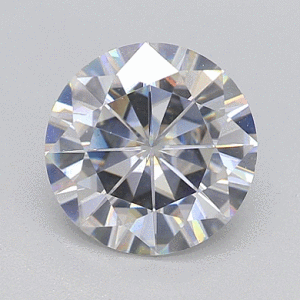
Moissanite – Poor light return and patterning
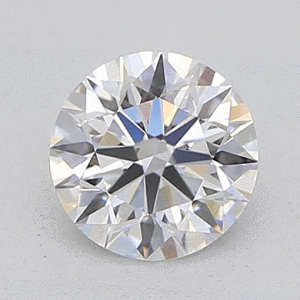
Diamond – Crisp, well defined patterning
Most moissanite stones are cut with shallow crowns and deep proportions. While this configuration boosts the gemstone’s fire, it compromises the brightness of the stone; resulting in unappealing dark, dead and glassy areas within the stone.
Keep a mental note of this and you will be able to see this effect clearly in the video comparison against a well cut diamond later.
Color – Diamonds can exist in a wide spectrum of colors from the hues found in a rainbow and in varying intensity tones. Most diamonds used in jewelry are white diamonds and are graded in the D-Z color range.
Moissanite is widely available in the near colorless ranges (G-J) and in a limited number of green/yellow tints. Some higher grade moissanite made using enhancement technology can achieve a similar D-F colorless appearance.
Fluorescence – A third of naturally mined diamonds exhibit blue fluorescence which is a cool feature I personally enjoy seeing and showing off to friends. On the other hand, synthetic moisannite doesn’t exhibit fluorescence due to their chemical composition.
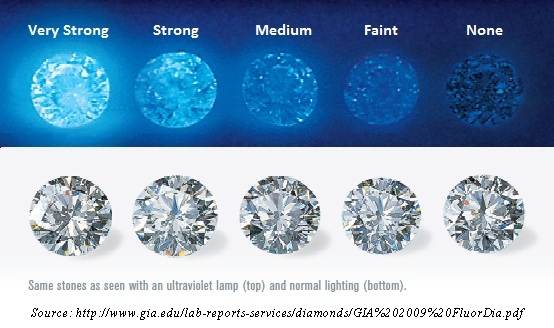
Both moissanite and diamond can be used to make beautiful engagement rings when chosen well. With diamonds, you can cherry pick one that’s truly well cut for sparkle with some due diligence.
On the other hand, you are pretty much at the mercy of the jeweler when buying moissanite because of the lack of tangible data (due to low costs) and the fact that most moissanite aren’t cut well to begin with.
Moissanite vs Diamond Side by Side Video Comparison
Moissanite is often touted as a low cost alternative to diamond with a comparable level of brilliance/sparkle. Well, that’s not true once you look at facts and understand the science behind light performance.
Don’t get me wrong here.
There’s nothing intrinsically wrong with the material properties of moissanite. They can be beautiful IF they are cut well. And that’s the crux of the problem. Most moisannite aren’t well cut because it takes a skilled craftsman and time (these cost money!) to polish them.
Due to economical reasons and the low selling price of moissanite stones, would you expect a master craftsman to have worked on a polished moissanite that costs less than $400? The cold hard fact is, most moissanite are cut terribly (including the one I bought).
Watch the following video depicting a side by side comparison between diamond versus moissanite in different lighting environments below…
There’s something else I want to highlight here as well. Due to moissanite’s higher refractive index, they tend to display more fire (rainbow effect) and this is noticeable even in diffused natural lighting.
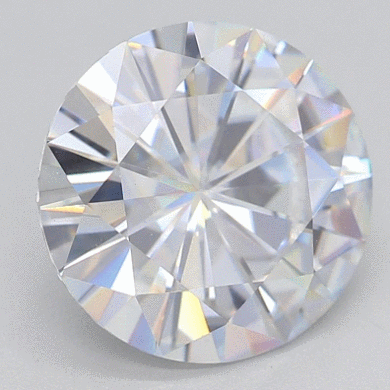
Moissanite under magnification with oily appearance.
While some people love the color display of light, there are many others who think this makes the stone look “fake” and “artificial”. The phenomenon is more pronounced in larger carat size stones where they display an “oily like” surface.
Using a Diamond Tester on Moissanite and Diamond
Moissanite vs Diamond Price Comparison
Being a simulant, moissanite is obviously less expensive than the real thing. Let’s do a cost comparison between diamond and moissanite to give you an idea of how much they cost. In general, you can expect to pay less than a tenth of a diamond’s price for a loose moissanite.
While moissanite may be relatively cheaper than diamond, I personally feel there are much better alternatives. Compared to other types of simulants, moissanite is grossly expensive and the optical characteristics are nowhere near a diamond’s.
In fact, if you were going the route of a non-diamond engagement ring, cubic zirconia is going to be a much better option due to its lower cost and better appearance over moissanite.
Where to Buy Moissanite Rings or Diamond Jewelry?
I’m not a fan of moissanite but that doesn’t mean you have to agree with me. Having been in the trade and an avid gemstone collector, I have raked up alot of experience with different vendors and made a number of purchases.
When it comes to moissanite engagement rings, one of the best places to buy them is at Brilliant Earth. They have a range of moissanite in different carat ranges and sizes. More importantly, the settings they make are well crafted and beautiful.
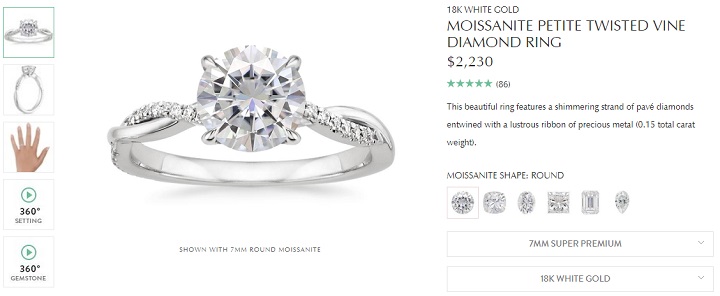
Click here to browse Brilliant Earth’s collection of moissanite engagement rings…
Diamond vs Mosannite – Which is For You?
Ultimately, the choice between diamond versus mossanite boils down to personal preferences. If you are having trouble deciding, think about what you need the stone for. How important is it to have a diamond?
Can you do without it? Do you need the symbolic meaning of a diamond for a proposal ring or an anniversary gift?
Personally, I feel that moissanite is overrated and is a gemstone that pleases no one. As an alternative to diamond, it is extremely expensive and both its optical/physical properties doesn’t come close to being a diamond.
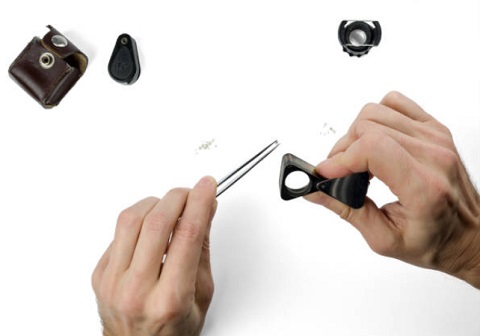
Here’s the thing.
Jewelers and businesses who peddle moissanite with vested interest often market them to be a “superior” alternative over diamonds. I call bullshit on such claims especially when it comes to optical performance.
If you are looking for a simulant that better resembles a diamond, cubic zirconium (CZ) is a much better choice over moissanite. Not only is it significantly cheaper and generally better cut, it is also easily available in departmental stores.
So, for people who are shopping for a diamond alternative, my advice is to ditch moissanite and buy CZ instead. With that, we’ve come to the end of the article. Now, I want to hear from you.
Related Articles
Leave A Comment

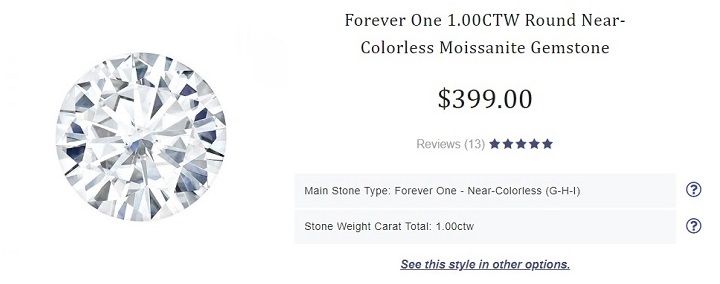
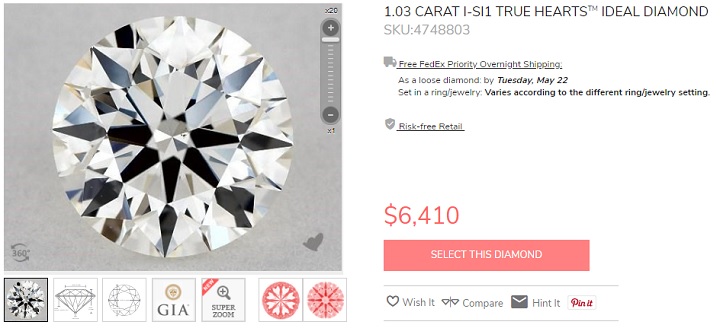
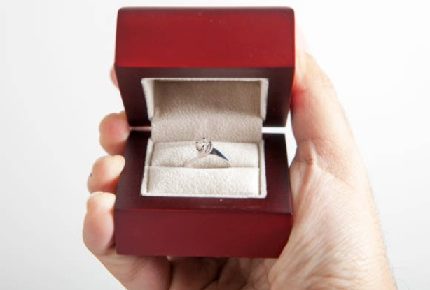
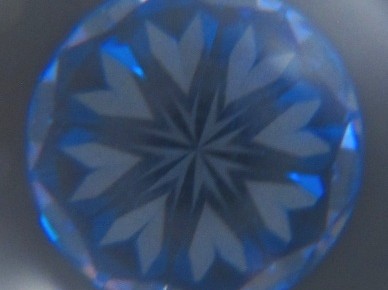











29 Comments
Besides the oily display, can you tell a moissanite vs diamond side by side apart from each other?
The easiest and surest way is to use a loupe. If you are asking whether you can tell the difference of a moissanite from diamond using the naked eyes, then you would have to look out for their different faceting pattern.
If you are observant, you probably realise the thinner arrows compared to the diamond’s nicely shaped arrow shafts. This is due to longer lower girdle facets and it gives moissanite a scintillation patterning with smaller flashes of light.
The caveat here is that inexperienced people would not know the things to be aware of.
If the moissanite diamond was so ugly, why did you buy it? Couldn’t you buy one that is well cut since you are the expert here?
Good question and that goes to show you are actually thinking and being critical of what you read.
With diamonds, you actually get to cherry pick within inventories and can make a purchase based on the exact specifications you want. It isn’t the same case for moissanite loose gemstones. There’s no such inventory for you to cherry pick from. What you do is to place an order based on carat weight and estimated color/clarity properties.
And then you pray for the best (not that it helps in anyway though because most of them are garbage tier cut quality). As a gemstone collector, I bought them for collection and for study purposes. As far as I know, there’s no vendor in the market that cares about cut quality when it comes to moissanite. Much of it is highly commercialized and peddled with marketing gimmicks claiming they are a “better” alternative to diamond.
I stand by my opinion that CZ is a better buy if you don’t want a diamond ring.
I was wondering why a larger carat size moisssanite diamond looks fake when I saw a couple of rings here at a local jewelry store. The smaller one looked closer to a diamond while the larger one didn’t. Your explanation on the oil appearance was exactly what I saw.
Yep. When facets are larger, the dispersion of light is easier to be seen with the naked eye. This wanton dispersion is what causes the larger size gemstones to look like a fake diamond.
By the way, it’s confusing to lump the terms moissanite diamond together. They should be separate terms as they refer to different things.
Have you reviewed a forever brilliant moissanite vs diamond before? What do you think about the brand? I would love to hear your thoughts.
Yep. I’ve reviewed them before. The Forever brilliant Moissanite is a premium line of gemstones from Charles and Colvard. It’s the one you see in the video.
I heard about the Rapaport price chart that is used by jewelers. Is there a similar moissanite diamond price list that is used?
No there isn’t. There simply isn’t too many segregations of categories with Moissanite to warrant such charts. Also, they are far too low valued for people to create something like this.
What a biased article! Moissanite look great and are much more ethical then the blood diamonds you are selling. Shame on you. Did you know how much environmental damage is caused because of mining?
You are standing on weak ground with lambasting arguments of moissanite as a better looking, conflict-free, glimmery alternative to diamond. While proponents of moisannite may claim that they don’t have “ethical” or “environmental” issues that plague diamonds as they are made in the lab, the same benefits could be said for lab created diamonds as well.
If you are so concerned about the environment, don’t even buy any jewelry to begin with. It’s hypocritical as their fabrication all require resources whether you buy a moissanite or a diamond. Heck, I could even argue that the electrical devices you own (i.e. lithium batteries) cause environmental damage.
For the record, I’m neither against nor for consumers buying diamonds. If someone doesn’t want to buy a diamond, so be it. It doesn’t affect me. This site is created for to help people come to an educated decision on what they want to buy.
I have made my stand clearly that consumers would be far better off with CZ over moissanite and that’s the best alternative if you are shopping for a non-diamond engagement ring.
Oh, what a load of crap… I’m sorry, the only thing that you have convinced me of by writing this BS is that you are grossly biased towards diamonds…you are peddling and perpetuating the ugly DeBeers marketing strategy that has brainwashed our society towards diamonds. You really think that at $399 part carat is grisly overpriced and a diamond at $6,00 is not? I’d choose moissanite over diamond or CZ any day. And for you to say that CZ is a better option, you truly know nothing about what CZ is…stop regurgitating the crap you’ve red and selling it to those who don’t know any better.
Well, all you need to do is to look at the gemstones and underlying performance. If you want a gemstone that looks and copies the appearance of a diamond, the closest and cheapest alternative is CZ. In case you don’t know the market (and your comments clearly shows how ignorant you are), a decent quality CZ costs about $1/carat.
Moissanite doesn’t look like diamond at all. That’s a fact. Look at the scientific data and use your eyes. And as a disclosure, I own and buy all 3 types gemstones. I have no bias for diamonds or anything against CZ. I have no love for De Beers as well. For the record, I don’t sell diamonds.
You probably want to re-read the entire article. I will reiterate, for people who are looking for alternatives, moissanite is pricey and doesn’t have the performance compared to CZ.
What about fancy cuts like Emerald?
Both diamonds and moissanite wont exhibit the same kind of fire/scintillation because of the cut. Would it then warrant a moissanite consideration?
Mostly because I’ve heard that CZ gets cloudy over time and also that CZ breaks much easier.
Low quality CZ from the past decade does turn cloudy overtime compared to those manufactured now. That said, even if your CZ does turn cloudy, you can simply throw it away and get a new one. The cost is really negligible compared to buying a moissanite or diamond. And CZ doesn’t “break” that easily contrary to what you think. On the hardness scale, CZ is a 9.
Hi Paul, do you have a similar article comparing CZ vs diamond? Wondering why you say that a CZ is most comparable to a diamond. Also wondering where you’d recommend for buying a quality CZ ring? Thanks!
The refractive index and appearance of a CZ is most alike to a diamond. Other diamond imitations are not only more expensive but also look completely different.
Hi Paul,
Thanks for your site. I have found it handy and have learned a lot!
I’m in the process of deciding and doing a lot of research.
Would you mind to share your thoughts about the Diamond industry? I know you shared some in earlier comments about the ethics behind lithium batteries etc. but if you could shed more light that would be most helpful!
Thanks a lot
Sure, let me know more specifically which aspect of the diamond industry are you looking at. Is it ethics on mining, environmental, consumerism?
I’m grateful for your insight. For the longest time, I thought I saved by buying a 1 carat moissanite. I always thought something was off about my moissanite until recently I learned more about gemstone cut, etc. The cut quality is off. I didn’t know all I wanted was a diamond, not even a big one, like less than half a carat well cut diamond will do. I sold my moissanite ring and bought a pear cut solitaire, 0.4 carat, well cut, from Blue Nile. It cost less than $600 in total, cheaper than my moissanite ring. What was I thinking? Hindsight 20 20. Thanks again!
I think I need to provide some consumer insight to your analysis that is missing. It is my opinion that many people in this comment section believe you are a diamond-shill because you fail to incorporate a major aspect of jewelry ownership in your assessment- real life wear. I own both. I spent an INSANE amount of money on the most perfect diamond because I wanted it to shine like anything.
I don’t even wear it. I wear my moissanite ring that was meant to be the one I take on travel every day. Why? Simple. After a weeks wear, all of the buildup from lotions, even if you’re careful not to get it on your ring, will make them look the same. My diamond ring? I have a semi-professional steam cleaner that I use in between getting it cleaned at the jewelers. It takes forever to get it clean enough to sparkle like new. My moissanite? Well, I throw some windex on it and totally don’t care if its abused at it’s price point and it comes out sparkling like its been hand polished.
Light performance is its potential. Much like human potential, its not often realized in practice.
Yep. Cleaning is definitely an important aspect of wearing jewelry if you want them to look their best. Diamonds are oil magnets because of their properties and surface. It really is different strokes for different people. For people who want a cheaper alternative, I recommend CZ instead as they are really cheap and at their price point, I won’t even bat an eyelid if I lost the CZ ring.
I understand that is your recommendation. It’s not mine. It’s not many women’s who regularly wear jewelry of all stones. I’m honestly surprised it is the recommendation of a professional.
Going back to the importance of not comparing things in its ideal, impractical conditions (perfectly cleaned, under high intensity light, inches of viewing distance or even loops), you have to consider how jewelry is worn every day. That means, mostly daylight, maybe cleaned once every 2 weeks (laughable if you have kids or a career…more like every month at best) and mostly viewed from a couple feet away. If you ever show off a ring to someone, they’re taking a maximum 5 second glance while its still on your finger. I know very few people who would take the ring off and hand it to someone to take a close look. So, given these parameters, what looks the best?
It’s not CZ. It’s never CZ. CZ is SO easy to tell apart under these conditions. Its too glassy. And most settings for CZ look cheap. It’s major tell when you see two prongs per side stone and cheap metal alloys. Even if you were to get a CZ and put it into a nice setting as a cheap alternative, you can’t eliminate the glassy appearance.
Diamond is ideal but who the hell wants to deal with it? Its expensive to get something cut in a super ideal way. The fire and brilliance require a 1 carat or more for it to really stand out. Meanwhile, you never clean it because you’re worried about how chemicals are reacting to your ring. No one buys a steam cleaner for their home except people like me who care very much about their jewelry. Hardly anyone has time to go get it professionally cleaned. Diamonds, in practice, are the WORST for every day use. So many people will go into pools with their diamond rings…. the chlorine. They’re clean with their rings on…the hydroxides.
I’m a huge advocate for moissanite, despite having a quite a few diamond pieces. Theyre placed in a “real” setting. Combined with a real setting and the fact you can mistreat it, you can clean it fast, easy, frequently. With that frequency of cleaning and the fire it gives off during daylight, it will convince ANYONE its real. My moissanite is an exact replica of my real engagement ring (for travel and when I don’t want to worry). I get so many compliments, its ridiculous.
Understanding their customer is how moissanite blew up.
Well, you probably haven’t seen the higher quality CZ stones. I can tell you that its impossible for a trained professional to tell a well cut CZ apart from a diamond without magnification tools. Moissanite gives off an oily and overly firey appearance. It’s completely different from that of a diamond’s and very very easy to tell apart. Plus, it’s not as if moissanite doesn’t get dirty and you are misguided if you assume diamond rings need “chemicals that react to your ring” for cleaning.
You may prefer moissanite’s appearance. That’s fine. Plenty of people don’t and that includes myself. You can have your opinion about everyday wear and how diamond rings are not suitable for it. Contrary to that belief, diamond rings are much easier to maintain than moissanite rings whether its because of the base metal used. And to your point, if you want to mistreat a ring, the ring with the diamond will hold up better than one with a moissanite with all things being equal.
Hi Paul,
I have been following your articles for years and they are really helpful. I love how you voice out your honest opinions about diamonds and the others.
Just finished reading this article, and im just wondering if you have any websites to recommend for well cut cz stones? I would like to try it out. I have seen moissanite and they look too white and pale to me which i did not buy it in the end.
Thanks loads
You may want to check in with Wink Jones of HighPerformanceDiamonds.com to see if he can help you source for a super ideal cut CZ.
Good day Mr. Gian!
I just wanted to say thank you so much for your site and for educating all your readers and being so polite even to the people on the internet who can be so vitriolic towards you haha. I remember coming across your site years ago when I had only a passing interest in researching my future engagement ring. It’s so nostalgic coming back full circle to find this article and rereading the rest of your site now that I have such a wealth of knowledge and information that I gathered from JannPaul, the PriceScope forums, and yourself. I can easily see how I would have been duped into buying an inferior diamond if I didn’t put the hours of research I have, thanks to the resources people like you have created for us.
I find myself agreeing with pretty much everything you write about, right down to avoiding the diamond districts and how cubic zirconia is superior to moissanite for a gemstone that is most similar to a diamond. It’s so weird to me how aggressive some moissanite proponents are in their lambasting of diamonds. It gives me the impression that they’re insecure in their own choice of gemstone and they need to denigrate diamonds to feel justified in having a moissanite. I don’t get it. If people want a moissanite, that’s great, not like they’re inferior to diamond owners, but sometimes, the chips on their shoulders on the internet make me think they sure feel inferior somehow.
Absolutely loved your honest comparison of a moissanite to a super ideal cut round brilliant. While it’s probably true that most laypeople like myself wouldn’t be able to tell apart a moissanite from a generic inferior cut diamond, the difference of a super ideal cut diamond from a moissanite is clear as day. As simple as looking at the arrows’ contrast patterning. Never going to see that on a moissanite, at least with current quality standards in that industry. Whenever I see rings with stones without those stark black arrows, I know instantly that it’s either a moissanite or someone got ripped off. Hopefully, with your blog, the latter becomes less and less common.
I find it fascinating that you have not mentioned JannPaul anywhere on your blog. While they are a Singapore retailer, the information on their YouTube channel is remarkable and their decagon diamond is really impressive, among other proprietary cuts that they have. But the decagon diamond in particular has blown me away. I wonder if you’ve heard of it and seen the videos on it. Seeing their comparison videos of a GIA standard triple excellent cut, their own super ideal cut round brilliants, and that decagon diamond, it seems like its light performance outperforms even the best round brilliant cuts. Any chance you would want to get a hold of one and give us a review on it? In my own research, I’m pretty convinced its the best light performing diamond out there and I have my heart set on buying it from them, not just for the gemstone quality but also to support their mission to educate every other layperson, but I’d definitely be interested in your expert opinion!
Thank you again for all your hard work, looking forward to reading your blog for many more years!
This!!! This was the article I was looking for. I never understood why moissanite looks dull compared to a diamond even if there are so many videos and posts that tells that it looks exactly like one and no one will be able to tell the difference. Now it all makes sense. Thank you for this article. I also agree smaller cushion moissanites look better. I have read almost all of your articles. Great articles and great work. Appreciate the effort. Good read!